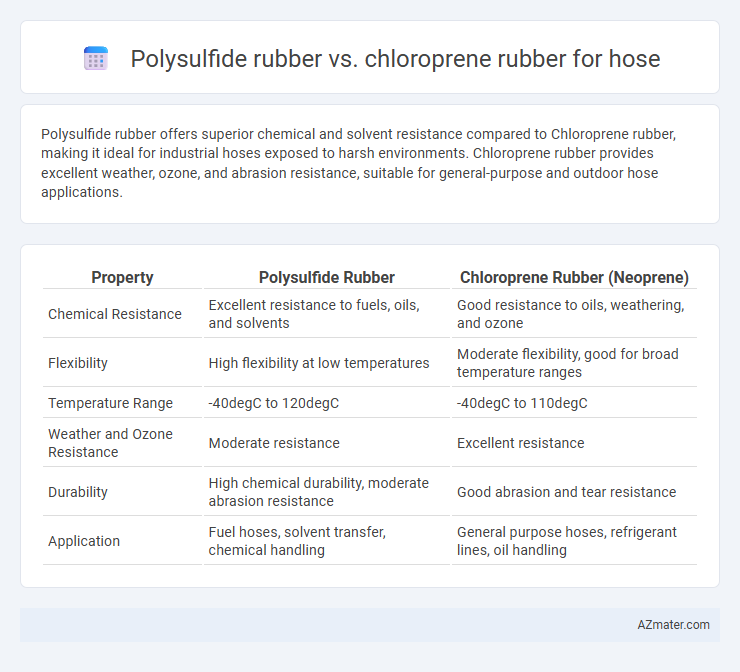Polysulfide rubber offers superior chemical and solvent resistance compared to Chloroprene rubber, making it ideal for industrial hoses exposed to harsh environments. Chloroprene rubber provides excellent weather, ozone, and abrasion resistance, suitable for general-purpose and outdoor hose applications.
Table of Comparison
| Property | Polysulfide Rubber | Chloroprene Rubber (Neoprene) |
|---|---|---|
| Chemical Resistance | Excellent resistance to fuels, oils, and solvents | Good resistance to oils, weathering, and ozone |
| Flexibility | High flexibility at low temperatures | Moderate flexibility, good for broad temperature ranges |
| Temperature Range | -40degC to 120degC | -40degC to 110degC |
| Weather and Ozone Resistance | Moderate resistance | Excellent resistance |
| Durability | High chemical durability, moderate abrasion resistance | Good abrasion and tear resistance |
| Application | Fuel hoses, solvent transfer, chemical handling | General purpose hoses, refrigerant lines, oil handling |
Introduction to Polysulfide and Chloroprene Rubber
Polysulfide rubber features exceptional resistance to chemicals, oils, and solvents, making it ideal for hose applications requiring durability in harsh environments. Chloroprene rubber, known for its balanced mechanical properties and weather resistance, offers strong abrasion and ozone resistance suitable for general-purpose hoses. Both materials provide unique benefits in hose manufacturing, with polysulfide excelling in chemical stability and chloroprene delivering versatility across various industrial uses.
Chemical Composition and Structure
Polysulfide rubber features a polymer backbone with alternating sulfur atoms, providing exceptional chemical resistance and flexibility, especially against solvents and oils. Chloroprene rubber consists of a polymer chain containing chlorinated diene units, offering good resistance to ozone, weathering, and moderate chemical exposure. The sulfur linkages in polysulfide rubber create a more rigid, dense network compared to the chloroprene's less cross-linked structure, influencing their respective durability and application in hoses.
Key Performance Properties Compared
Polysulfide rubber offers superior chemical resistance and excellent fuel barrier properties, making it ideal for fuel hoses exposed to aggressive solvents and oils. Chloroprene rubber exhibits outstanding weatherability, ozone resistance, and good mechanical strength, suited for hoses used in outdoor and industrial environments. Both materials provide flexibility and durability, but polysulfide excels in impermeability while chloroprene emphasizes longevity under harsh environmental conditions.
Flexibility and Elasticity Differences
Polysulfide rubber offers superior flexibility with excellent resistance to fuel, chemicals, and ozone, making it ideal for hoses requiring long-term durability under harsh conditions. Chloroprene rubber, while also flexible, provides higher elasticity and better resilience to weathering and aging, suitable for dynamic applications involving frequent bending and stretching. The main difference lies in polysulfide's enhanced chemical resistance and moderate elasticity versus chloroprene's balanced flexibility and greater elastic recovery.
Chemical and Oil Resistance
Polysulfide rubber exhibits superior chemical resistance, particularly to acids, alkalis, and solvents, making it highly effective for hoses exposed to aggressive chemicals. Chloroprene rubber offers excellent oil resistance and maintains flexibility in various temperatures, suitable for hoses handling petroleum-based fluids. When selecting hose materials, polysulfide rubber is preferred for harsh chemical environments, whereas chloroprene rubber excels in applications involving oils and fuels.
Weathering and Ozone Resistance
Polysulfide rubber offers exceptional weathering and ozone resistance, maintaining flexibility and strength under prolonged exposure to harsh outdoor conditions, making it ideal for hose applications in extreme environments. Chloroprene rubber, while also resistant to weathering and ozone, typically exhibits slightly lower durability and flexibility compared to polysulfide rubber when exposed to UV radiation and ozone over long periods. Industries demanding superior environmental resistance often prefer polysulfide rubber hoses for their enhanced lifespan and reliability against weathering and ozone degradation.
Temperature Tolerance and Stability
Polysulfide rubber exhibits superior temperature tolerance, maintaining flexibility and chemical resistance in ranges from -40degC to 120degC, making it ideal for extreme temperature hose applications. Chloroprene rubber offers stable performance between -40degC and 90degC, with good resistance to oxidation and weathering but lower heat resistance compared to polysulfide. Stability under thermal stress favors polysulfide due to its molecular structure, which reduces degradation and ensures longer hose lifespan in high-temperature environments.
Typical Applications in Hose Manufacturing
Polysulfide rubber is primarily used in hose manufacturing for applications requiring excellent chemical resistance and flexibility, such as fuel hoses, brake hoses, and oil transfer lines. Chloroprene rubber (Neoprene) is favored for hoses exposed to weathering, ozone, and moderate chemicals, commonly utilized in air hoses, hydraulic hoses, and refrigerant transfer hoses. Both materials deliver durability, but Polysulfide excels in fuel and oil environments, while Chloroprene is preferred for versatile industrial and automotive hose applications.
Cost Considerations and Availability
Polysulfide rubber tends to have a higher material cost compared to chloroprene rubber, impacting overall hose production expenses. Chloroprene rubber is widely available and benefits from established manufacturing supply chains, leading to more competitive pricing and quicker procurement. Cost efficiency combined with broader market availability makes chloroprene the preferred choice for many hose applications over polysulfide rubber.
Choosing the Right Rubber for Hose Applications
Polysulfide rubber offers superior chemical resistance and flexibility, making it ideal for hoses exposed to solvents, oils, and extreme weather conditions. Chloroprene rubber provides excellent abrasion resistance and moderate chemical resilience, suitable for applications requiring durability against mechanical wear and moderate oil exposure. Selecting between polysulfide and chloroprene rubber depends on the specific hose application environment, considering factors like chemical exposure, temperature range, and mechanical stress.

Infographic: Polysulfide rubber vs Chloroprene rubber for Hose
 azmater.com
azmater.com